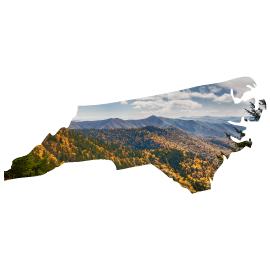Pension Sustainability: North Carolina
Pensions Policy
Analysis of North Carolina's policies
As of December 31, 2014, the most recent date for which an actuarial valuation is available, North Carolina's teacher pension system is 95.6 percent funded, an increase of 1.4 percentage points since NCTQ's last report. Its current pension debt is $2,000 per pupil throughout the state (about $1,000 per pupil after considering only classroom teachers). It also has a 12-year amortization period. This means that if the plan earns its assumed rate of return of 7.25 percent and makes its full actuarially determined contribution payments, it would take the state 12 years to pay off its unfunded liabilities. Both the funded ratio and amortization period are better than regulatory recommendations, and North Carolina's system is financially sustainable, according to actuarial benchmarks.
North Carolina, however, commits excessive resources toward its teachers' retirement system. The current employer contribution rate of 8.47 percent is somewhat excessive, in light of the fact that local districts also contribute to Social Security. The employer contribution is paid by the state, which lifts the burden from local districts, but it still uses funds that could have been used in more immediate ways to attract and retain effective teachers. The employer rate is determined according to statutory requirements, which mandate that the employer contribution rate must equal the cost to fund this year's expenses (the normal cost) plus any amount needed to amortize any unfunded liabilities. The mandatory employee contribution rate to the defined benefit plan of 6 percent is reasonable.
Recommendations for North Carolina
While the state meets actuarial benchmarks for a financially sustainable system, it does so at a somewhat high cost, precluding North Carolina from spending those funds on other, more immediate means to retain talented teachers. The state, however, must be careful to maintain its funding level to allow for protection during financial downturns. The state might consider systemic change such as directly tying benefits to contributions.
State response to our analysis
North Carolina did not respond to repeated requests to review this analysis.
Updated: December 2017
Select another topic
General Teacher Preparation
- Program Entry
- Teacher Shortages and Surpluses
- Program Performance Measures
- Program Reporting Requirements
- Student Teaching/Clinical Practice
- Teaching Methods
Elementary Teacher Preparation
Secondary Teacher Preparation
- Middle School Content Knowledge
- Middle School Licensure Deficiencies
- Adolescent Literacy
- Secondary Content Knowledge
- Secondary Licensure Deficiencies
Special Education Teacher Preparation
Alternate Routes
Hiring
- Requirements for Out-of-State Teachers
- Provisional and Emergency Licensure
- Licensure for Substitute Teachers
- Supporting New Teachers
Teacher and Principal Evaluation
Teacher Compensation
Retaining Effective Teachers
Early Childhood Preparation
How we graded
Research rationale
Under defined benefit systems, states have made an obligation to fund fixed benefits for teachers at retirement. However, the financial health and sustainability of many states' systems are questionable at best. Some systems carry high levels of unfunded liabilities, with no strategy to pay these liabilities down in a reasonable period, as defined by standard accounting practices.[3] Without reform, funding is unlikely to keep up with promised benefits and these systems will become increasingly vulnerable to collapse.
Pension plans disadvantage teachers early in their careers. By overcommitting employer resources to retirement benefits, these plans often require districts to depress salaries and restrict incentives. The contribution of employers to their workers' retirement benefits is a valuable benefit, important to ensuring that individuals have sufficient retirement savings. Compensation resources, however, are not unlimited, and they must fund both current salaries and future retirement benefits. Mandated employer contributions to many states' teacher pension systems are extremely high, leaving districts with little flexibility to be more innovative with their compensation strategies.[4] Lower mandatory employer contribution rates (in states where they are too high; in some states they are shamefully low) would free up valuable compensation resources to ensure pension systems are more sustainable and equitable for all teachers. In addition, some states require high employee contributions; the impact this has on teachers' paychecks may affect retention, especially early in teachers' careers.[5]
The burden placed on districts to fund unsustainable pension systems is further exacerbated for those in states where teachers also participate in Social Security, requiring the district to pay even more toward teacher retirement. While retirement savings in addition to Social Security are necessary, states are mandating contributions to two inflexible plans rather than permitting options for teachers or their employing districts.[6]
[1] Doherty, K. M., Jacobs, S., & Lueken, M. F. (2017, February). Lifting the pension fog: What teachers and taxpayers need to know about the teacher pension crisis. Retrieved from National Council on Teacher Quality website: https://www.nctq.org/dmsView/Lifting_the_Pension_Fog
[2] For an overview of the current state of teacher pensions, the various incentives they create, and suggested solutions, see Costrell, R. M., & Podgursky, M. (2011, February). Reforming k-12 educator pensions: A labor market perspective. New York, NY: TIAA-CREF Institute. Retrieved from https://www.tiaainstitute.org/public/institute/research/briefs/institute_pb_reforming_K-12_educator_pensions.html
[3] NCTQ's analysis of the financial sustainability of state pension systems is based on actuarial benchmarks promulgated by government and private accounting standards boards. For more information see U.S. Government Accountability Office. (2007). Government Accounting Standards Board statement No. 25. Retrieved from http://www.gasb.org/st/summary/gstsm25.html
[4] Costrell, R. M., & Podgursky, M. (2011, February). Reforming k-12 educator pensions: A labor market perspective. New York, NY: TIAA-CREF Institute. Retrieved from https://www.tiaainstitute.org/public/institute/research/briefs/institute_pb_reforming_K-12_educator_pensions.html
[5] For further evidence supporting NCTQ teacher pension standards, see The Segal Group, Inc. (2010). Public employees' retirement system of the state of Nevada: Analysis and comparison of defined benefit and defined contribution retirement plans. Retrieved from https://www.nvpers.org/public/executiveOfficer/2010-DB-DC%20Study%20By%20Segal.pdf
[6] For additional information on state pension systems, see Loeb, S. & Miller, L. (2006). State teacher policies: What are they, what are their effects, and what are their implications for school finance? Stanford University: Institute for Research on Education Policy and Practice. Retrieved from http://web.stanford.edu/~sloeb/papers/Loeb_Miller.pdf; and Hansen, J. (2008, May). Teacher pensions: A background paper. Committee for Economic Development. Retrieved from http://eric.ed.gov/?id=ED502293

